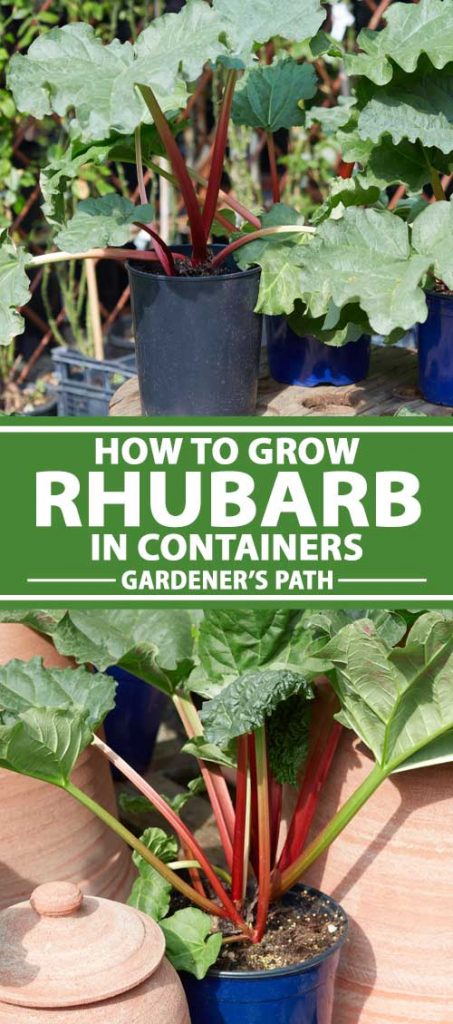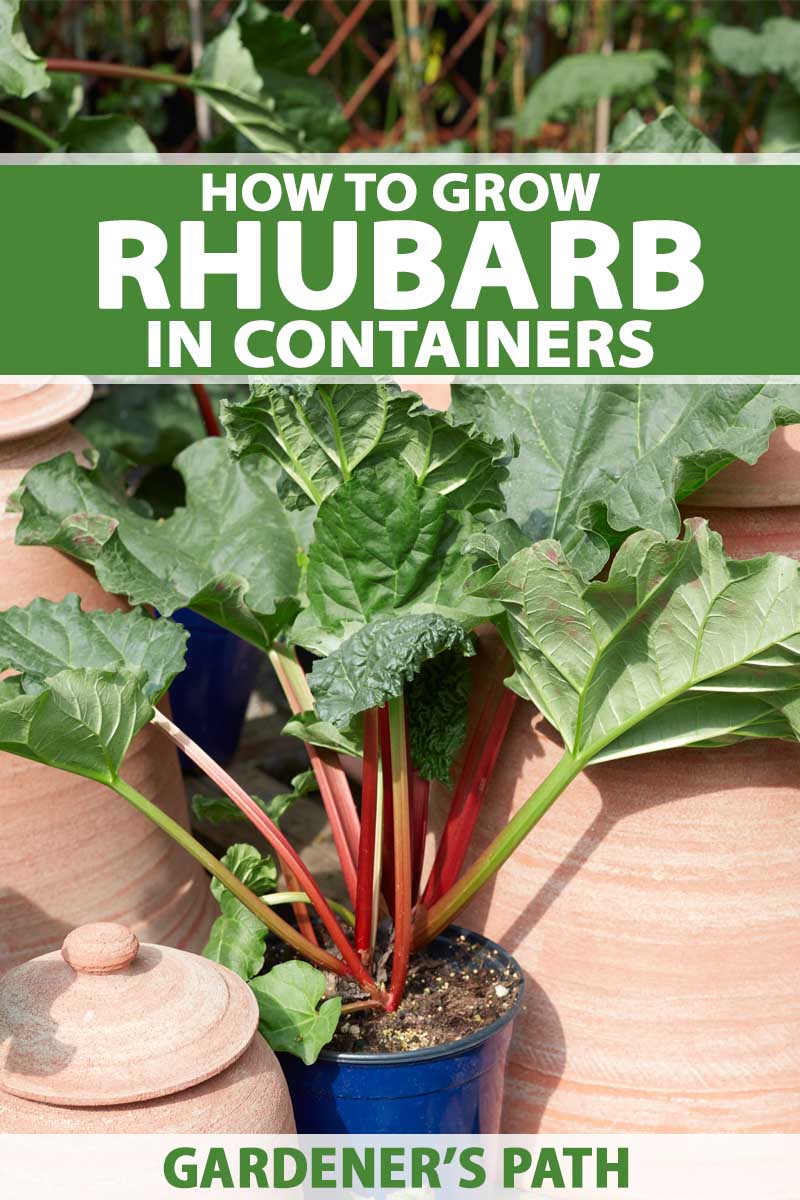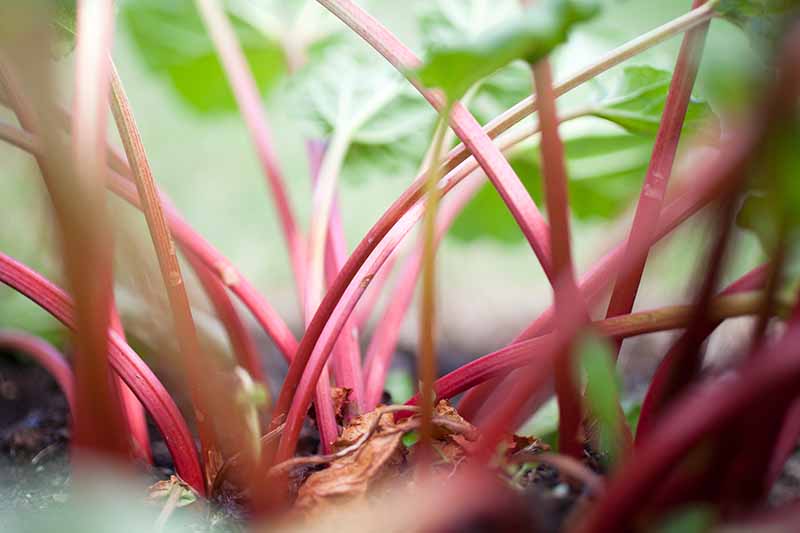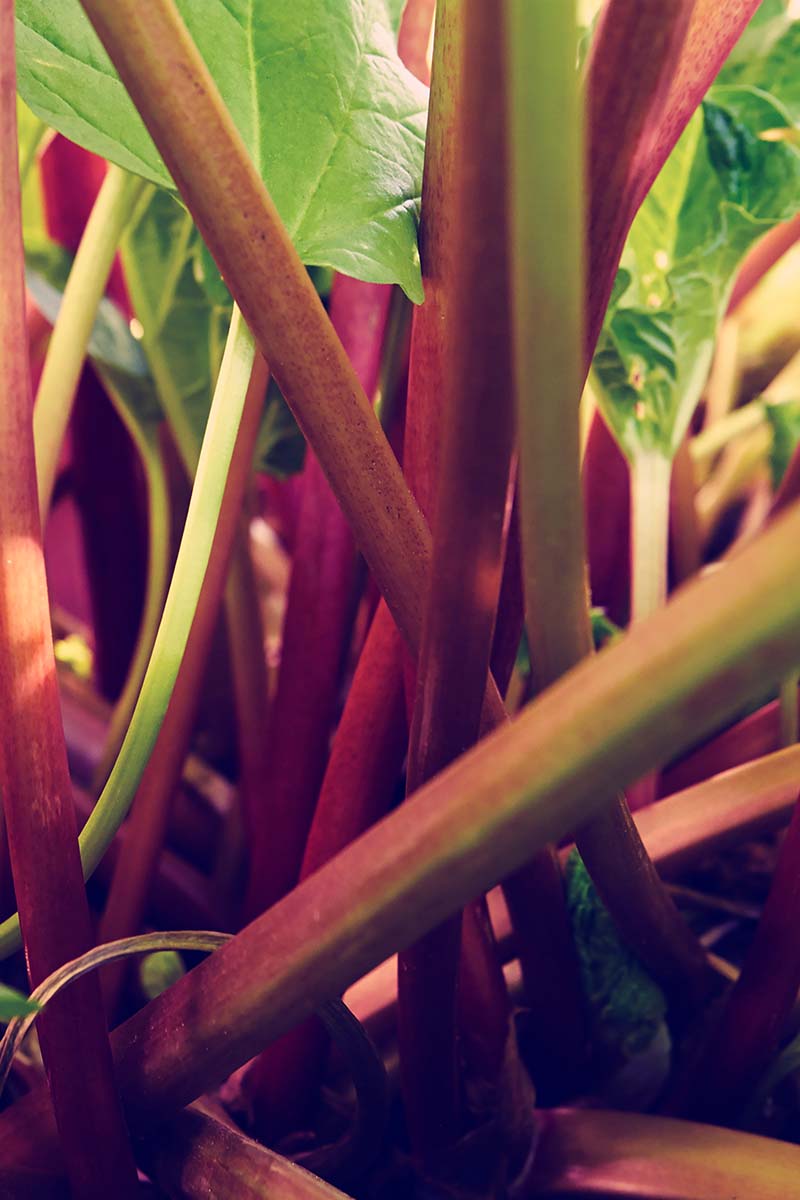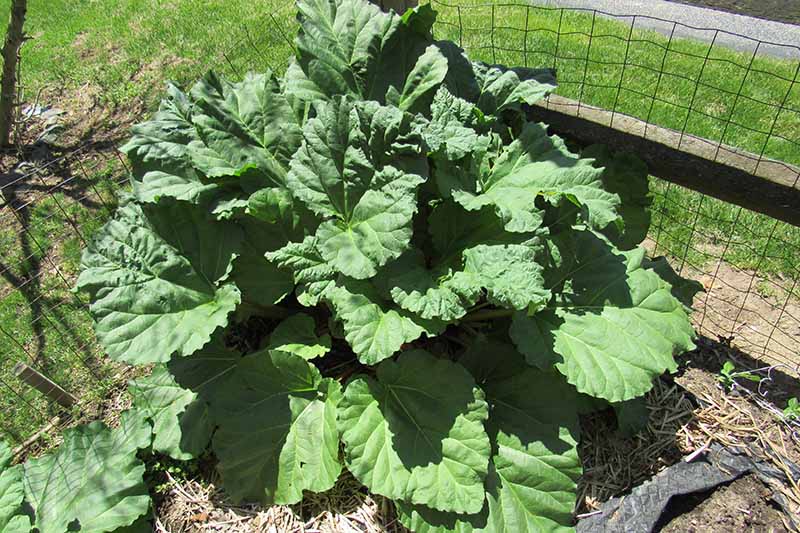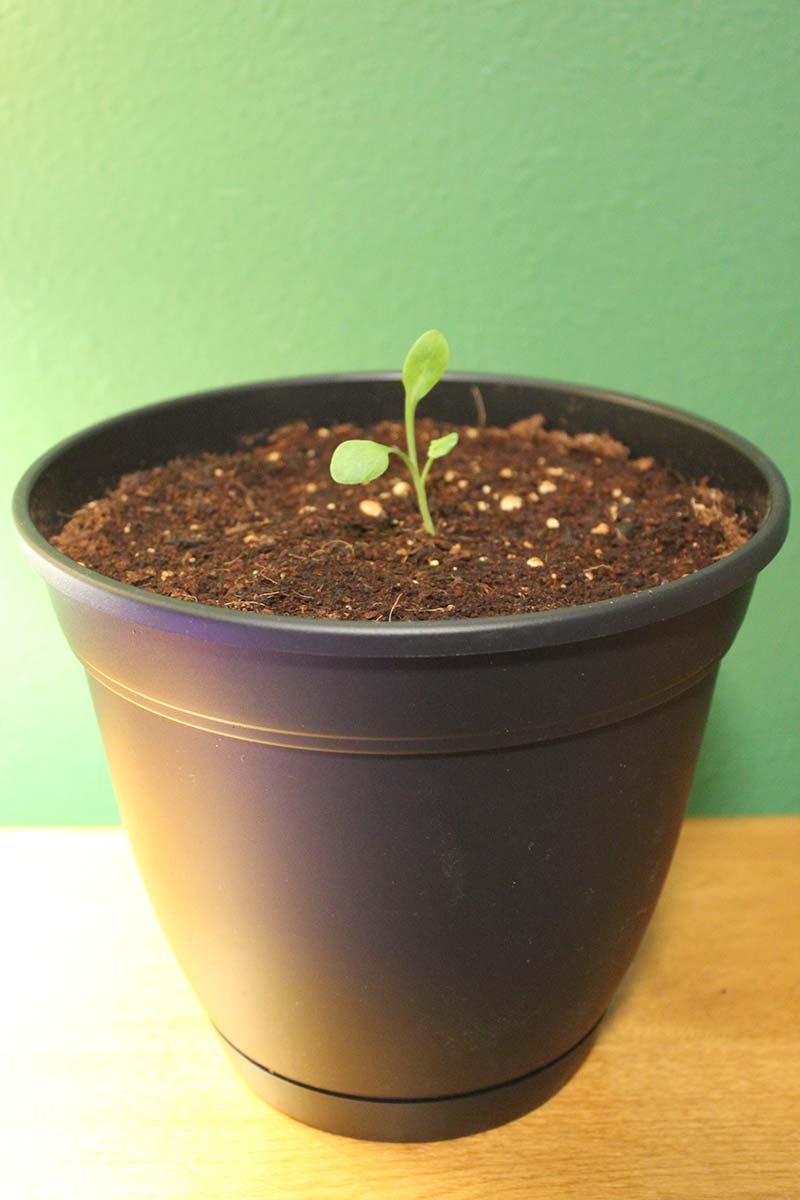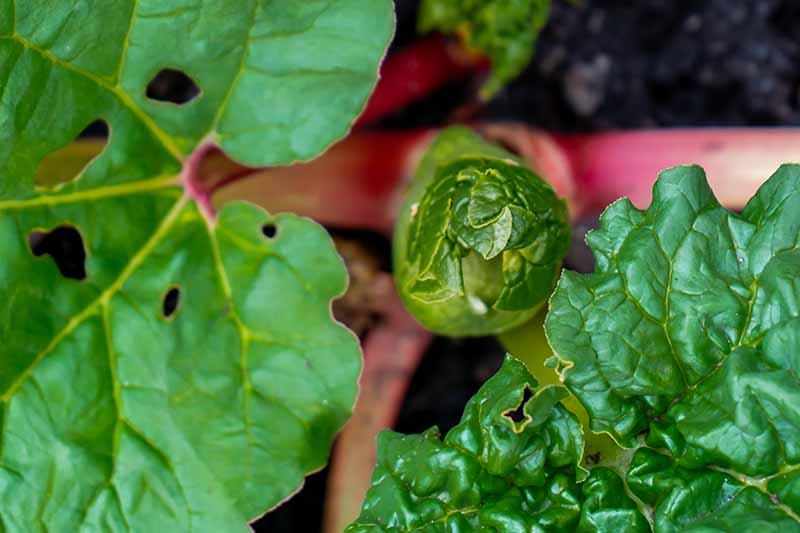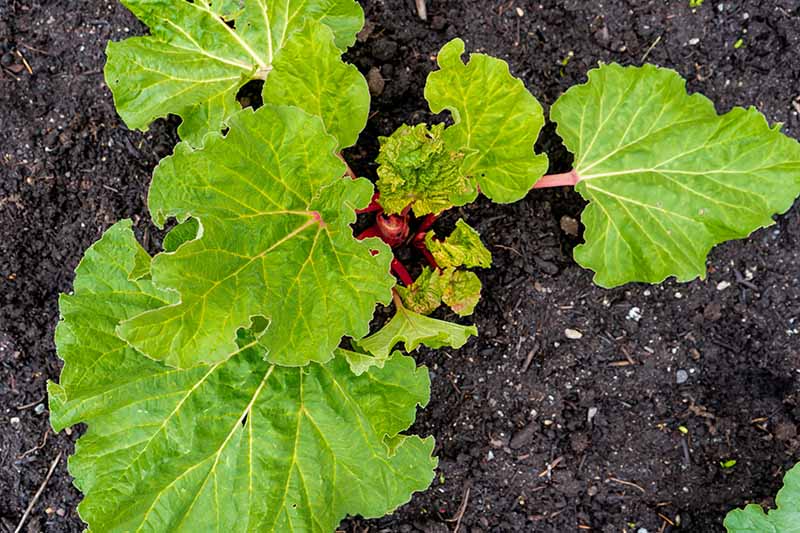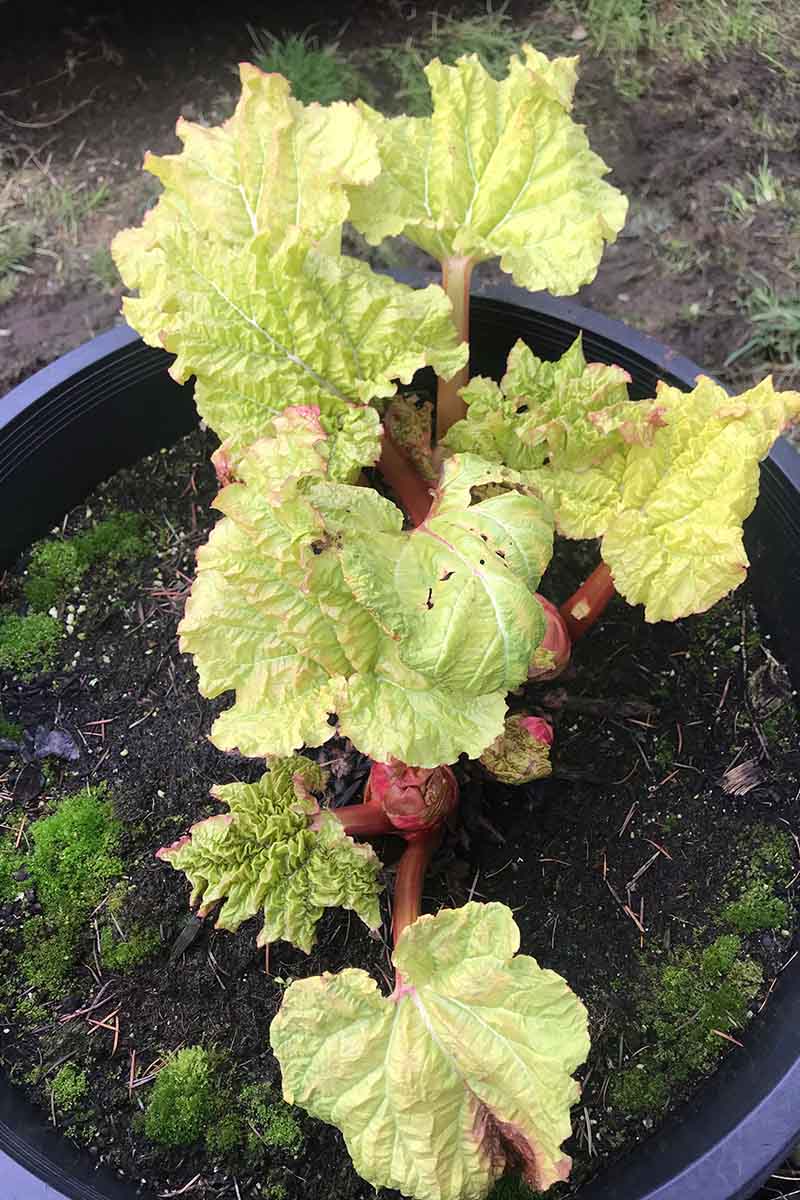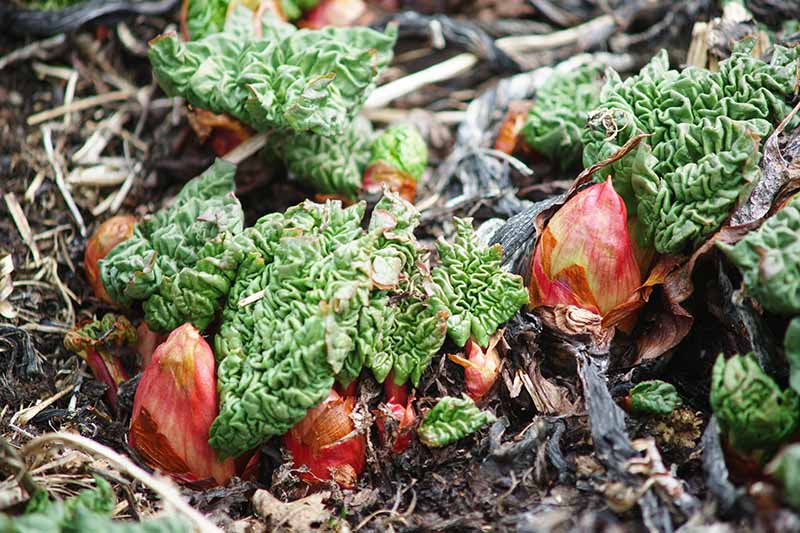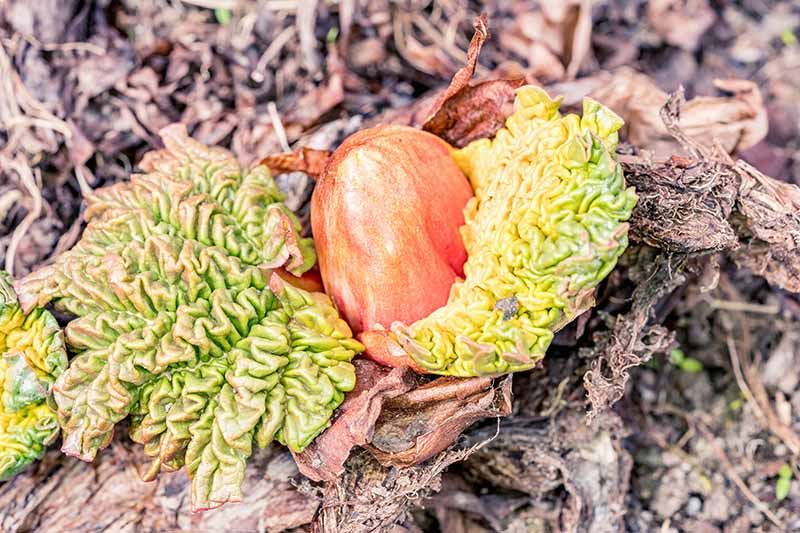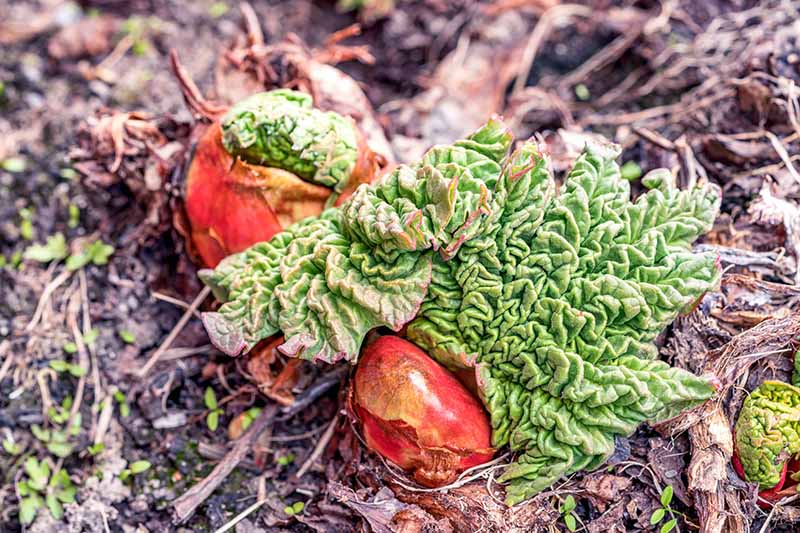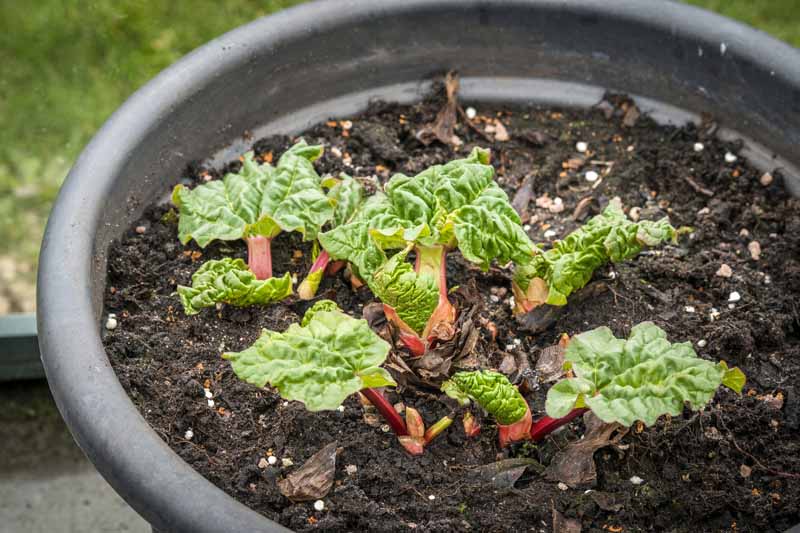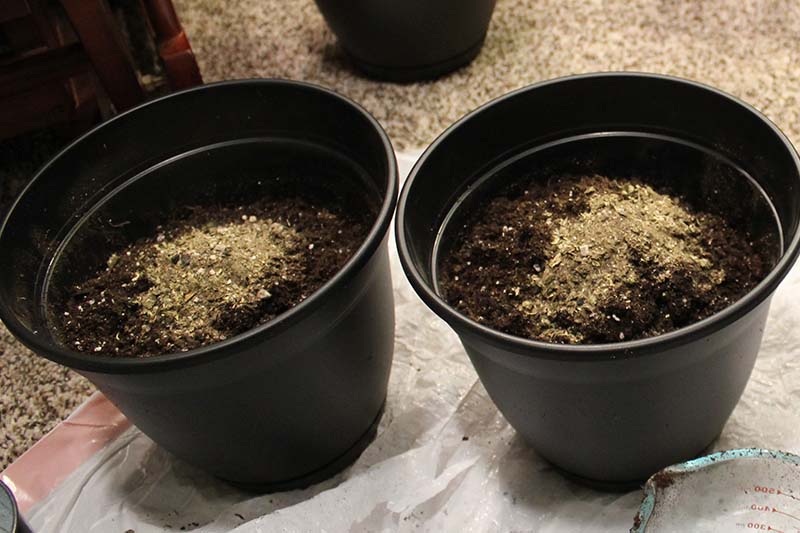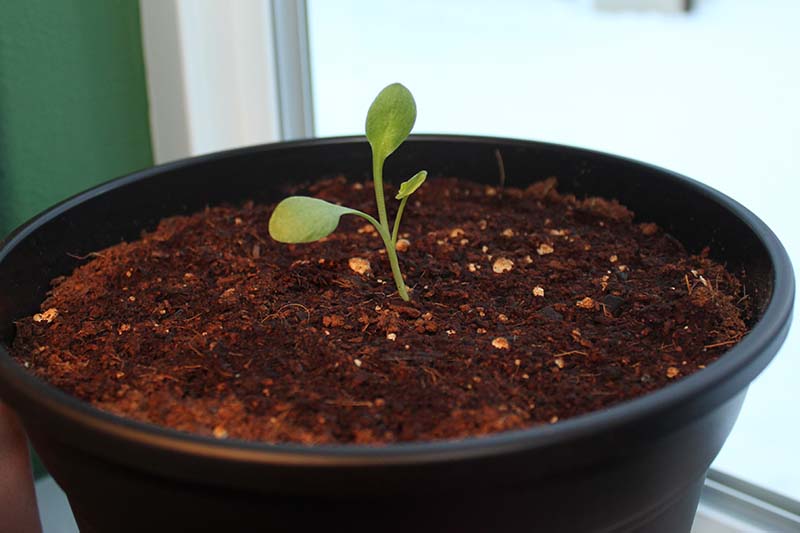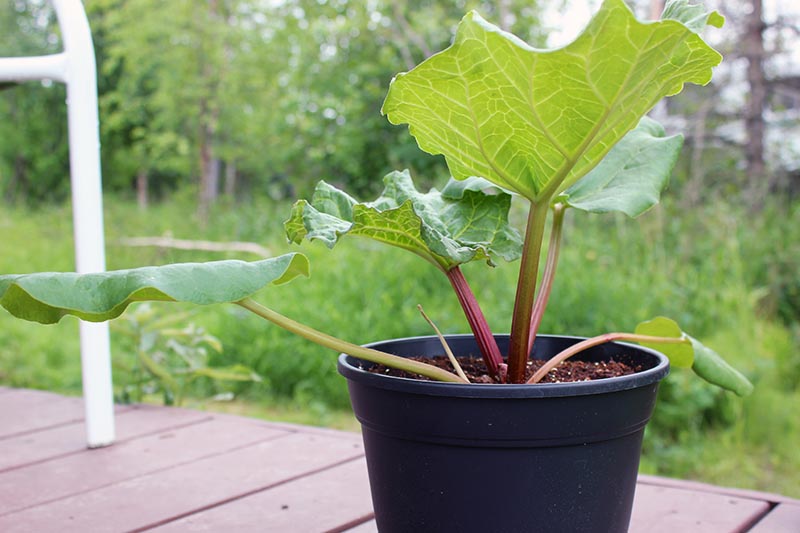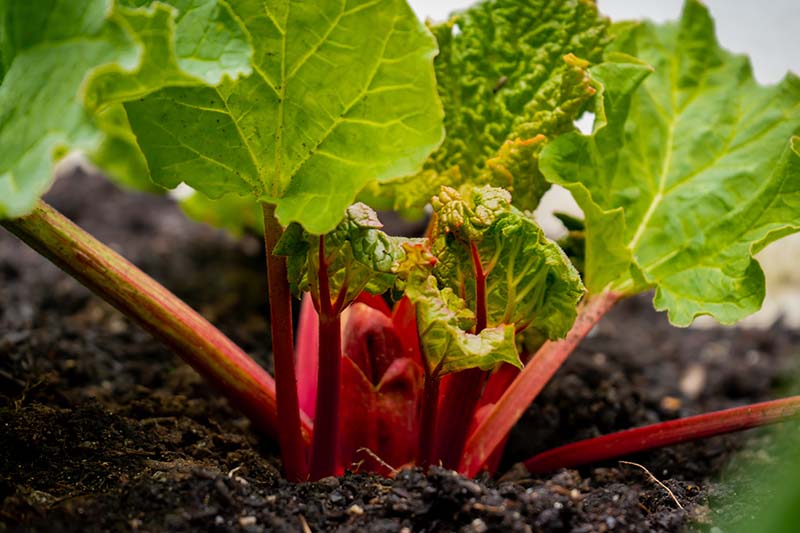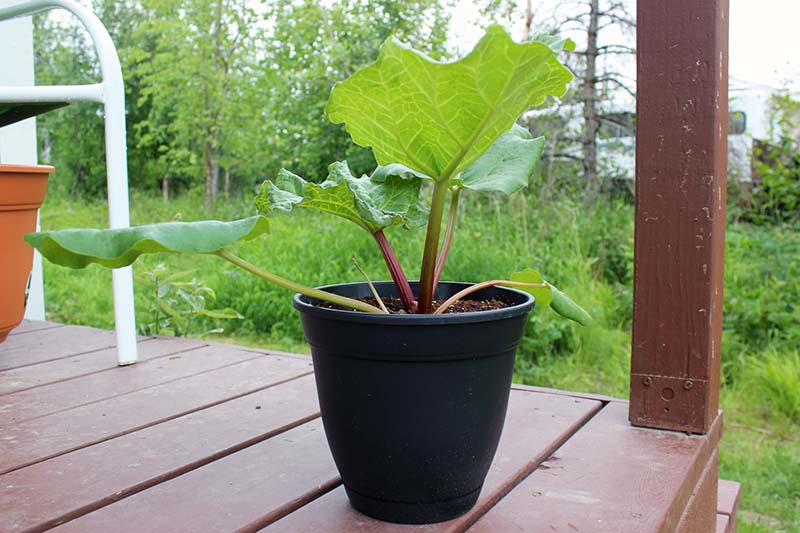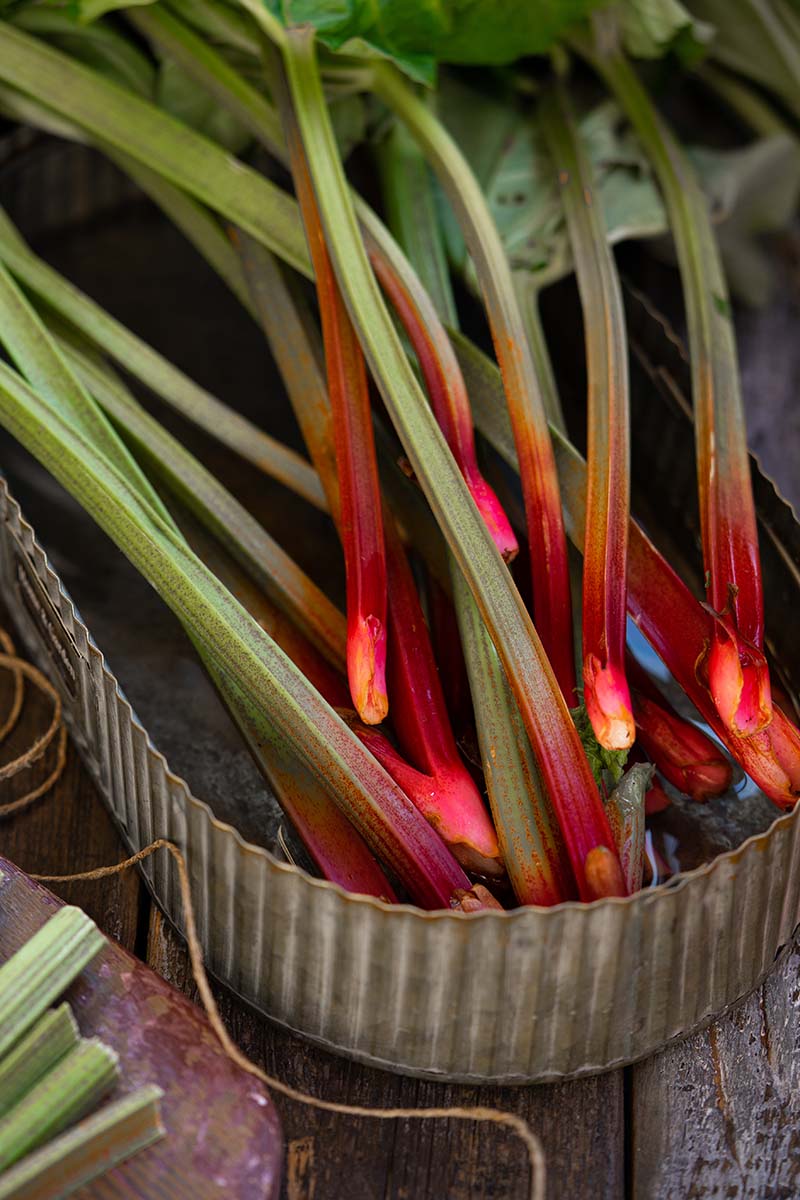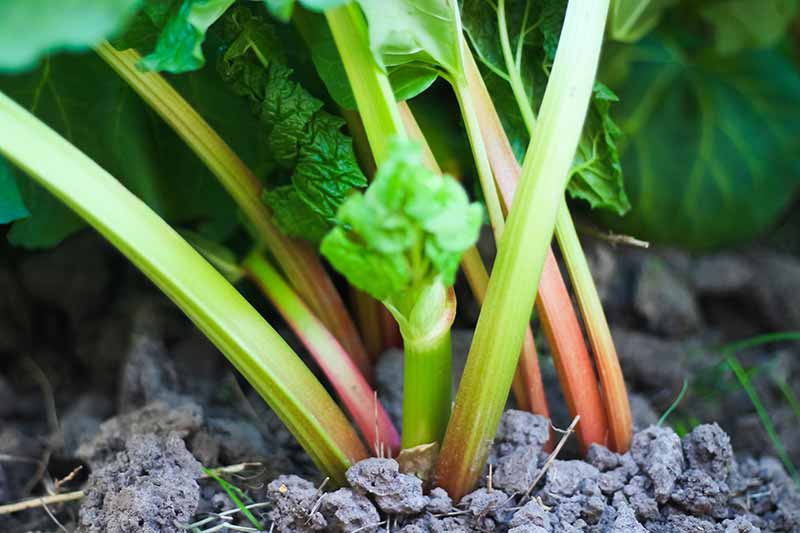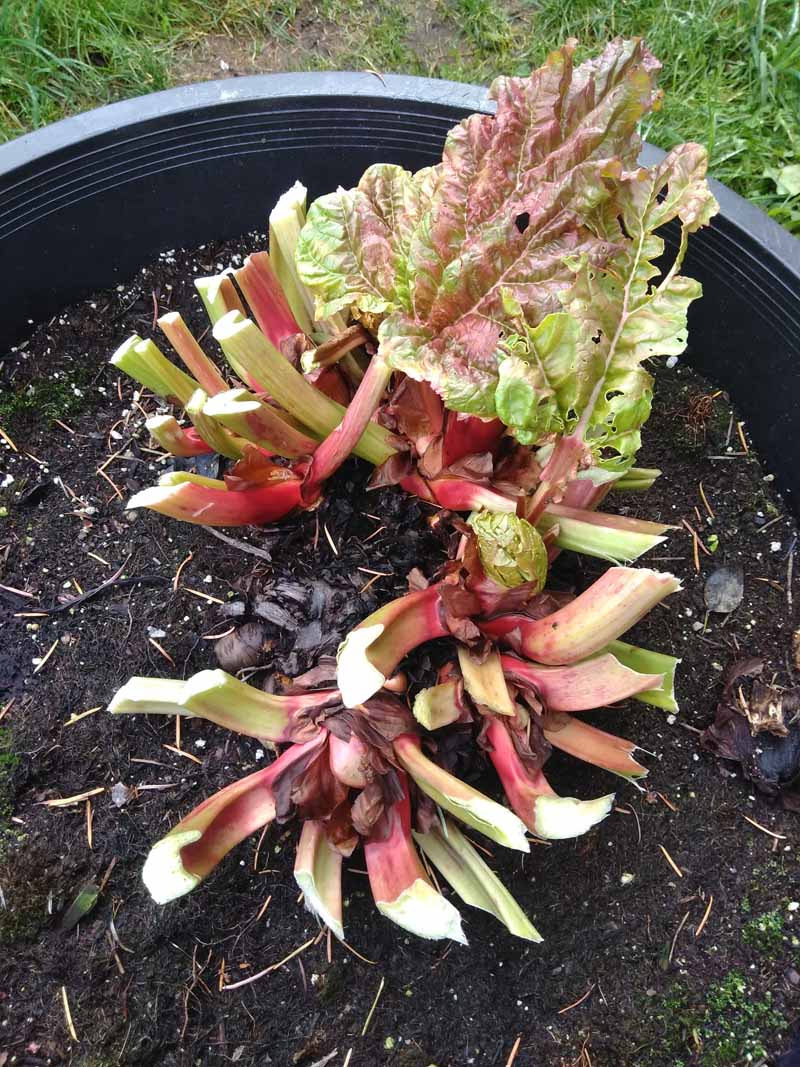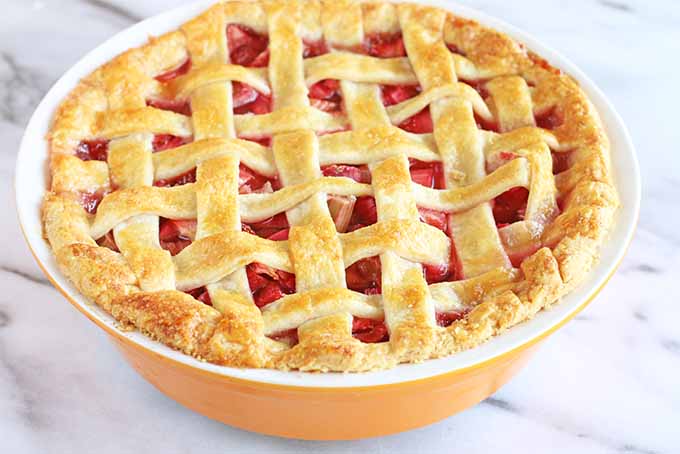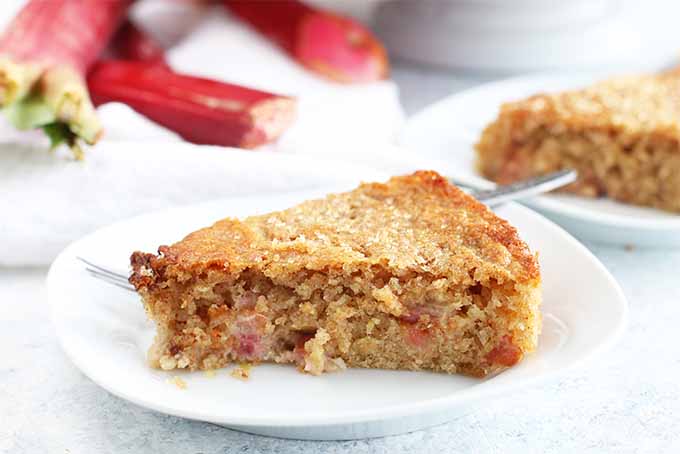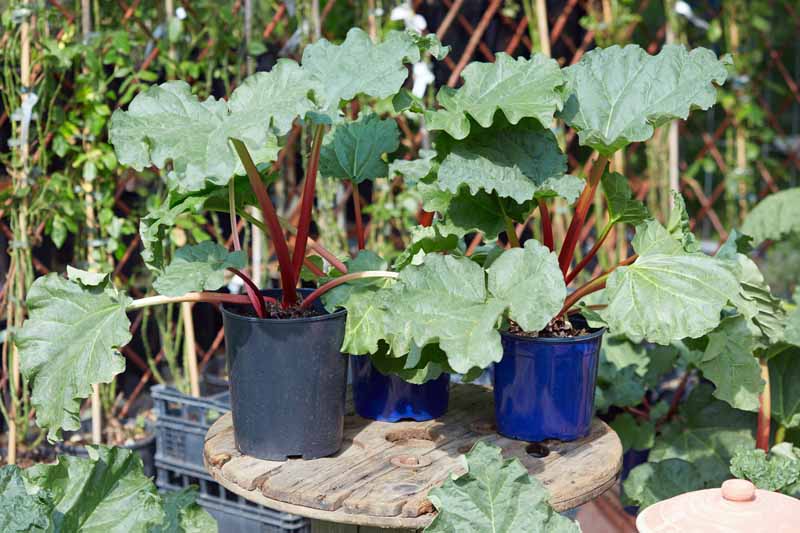That all changed the summer I moved to Alaska, when my parents convinced me to try the pie at a quaint local establishment, with the best view ever of the surrounding mountains and the Matanuska Glacier. Because of the breathtaking view plus gasp-worthy pie combo, we visit as often as we can. We link to vendors to help you find relevant products. If you buy from one of our links, we may earn a commission. That’s when I realized that I needed to grow rhubarb in containers at home during the winter.
My state may freeze for over half the year, but that doesn’t mean I can’t get a head start on growing my favorite pie filling in the world. And so can you! In this article, I’ll show you how. Here’s what I’ll cover:
Why Grow Rhubarb in a Container?
A member of the Polygonaceae family, Rheum rhabarbarum produces red or reddish-green stalks from springtime to early or midsummer, depending on the variety. While the leaves are inedible, or even toxic if consumed in large amounts, the stalks are deliciously edible.
Cooked down with buckets of sugar, they shine in a pie. That’s reason enough for me to want to grow a whole field of pie plant! Growing rhubarb in containers is an easy way to have your own fresh harvest of stalks, even if you haven’t got much space in your garden. Containers also help keep this plant in check. Once it’s established in your yard, rhubarb tends to take over, spreading so tall and wide – up to four feet both ways – that it can overshadow other crops growing in the area. In southern climes – USDA Hardiness Zones 9 and above – rhubarb plants perish when temperatures rise in the summer, which is why it’s often grown as an annual in those locations.
If it isn’t too hot out – meaning temperatures stay around or below 80°F throughout the hottest parts of the year – rhubarb thrives, and then naturally goes into dormancy during the late fall and into the winter months. Rhubarb then needs to chill out at a temperature of between 28 to 49°F or below for at least six weeks. This varies according the the cultivar you are growing, but on average, this plant needs 500 chill hours for best yields. For those in Zones 7 or 8, the weather doesn’t always comply with this requirement. Bringing your plant into a cool place like a basement or barn during these months will keep it happy during its winter rest period, allowing it to put all its energy into producing tasty new stalks come spring. This is easy to do if you grow your plants in a container.
Choosing the Right Container
Are you planning to plant crowns, divisions, or bare roots in pots outdoors? Then you’ll need a container that’s at least 20 inches tall and wide. It’s up to you whether you want to use a light plastic one, a more robust terra cotta variety, or something pretty and ornamental. Read more about what material is best for containers, pots, and planters here. For starting seeds that you’ll later transplant to a larger outdoor container, select a pot that’s at least eight inches wide and seven inches deep. This gives your plant plenty of room to grow and become established before transplanting time – without taking up scads of space in your house. Alternatively, you can start seeds in trays and transplant the seedlings later. Make sure you select a pot that has a draining dish, drainage holes that don’t leak onto your selected growing surface, or a self-watering insert. You can also fill a regular pot with a layer of gravel at the bottom to promote drainage away from the root system.
Preparing Your Container
Fill your 20-by-20-inch container with either:
Potting soil mixed with a little balanced 10-10-10 (NPK) granular vegetable fertilizer, according to package directions Garden soil amended with well-rotted manure or compost (about half and half)
Use a good quality, organically rich potting soil that drains well. Rhubarb enjoys soil with a pH between 5.0 and 7.0, or lightly acidic to neutral. If you’re using garden soil, you may need to amend it with compost or well-rotted manure. Conduct a soil test if you are unsure about the composition and pH level of your soil.
How to Grow
You can propagate rhubarb in four ways: from a crown (a one-year-old plant), a division, a dormant bare root ball, or seed. We’ll discuss each method as it pertains to container growing so that you can make the best selection for your garden.
Planting a Crown
A rhubarb crown is a good way to start if you want stalks that are ready to harvest in the first season after you’ve planted it.
Make a four-inch-deep, six-inch-wide hole in the soil. Carefully remove your crown from its planter. You may need to gently untangle the tendrils of the rhizome if the root ball seems very compacted. Next, set the root ball in the hole, and backfill with soil. Don’t cover any part of the existing stalks or leaves with soil. All you need to do is make sure the root ball is covered.
Give the plant a thorough soaking and set your container in a location that gets at least six hours of sun per day, preferably more. Keep the soil moist, but not soggy. For crowns planted in the fall, reduce watering over the winter months, and increase again when you see the first signs of life in springtime. Then keep the soil evenly moist but not waterlogged through the growing season.
If you have planted your crowns in the spring, get ready to watch them grow. As directed above, don’t overwater, but don’t let them dry out, either. While you may be tempted to start snipping those tasty stalks off immediately, don’t! Wait until stalks are 10 to 12 inches tall, and harvest lightly in the first season, taking only 1/8 to 1/4 of the plant’s total stalks. This will allow your plant to establish the strong root system it needs to produce truly delicious stalks starting one year after planting.
Planting a Division
If a friend is kind enough to give you a division from her rhubarb plant, rejoice! To divide them, you have to dig up the root and cut it in half (or into three pieces, depending on how large it is).
It is best to divide in spring, when the plant is first starting to wake up from its winter dormancy, or in the fall, just before it goes dormant. See our full guide to dividing perennials for detailed instructions on how to do this. Depending on the division time that you choose, the root balls (rhizomes) will be yellowish, chunky, tuberous things that may or may not have stalks and leaves attached.
Plant each division in a hole about eight to 10 inches deep, leaf side up. Cover all but the top inch of the root ball with soil, and leave any remaining stalks and leaves uncovered. Water the division thoroughly, and find the container a sunny spot on your porch or deck. If you’ve planted a rhizome that was divided in the fall, keep the soil moist until the plant goes fully dormant – in other words, until it dies all the way back. For spring-planted divisions, keep them moist throughout the rest of the spring and summer, and watch those mature stalks pop up. (Yes, you can harvest them!) Spring-planted divisions will grow quickly and will be ready for harvest as soon as the stalks are 12 to 18 inches long. For fall-planted divisions, you’ll be able to harvest stalks the following spring.
Planting a Dormant Bare Root Ball
A dormant bare root ball is essentially the same thing as a division. This is what the plant is called when you purchase it from a nursery, and it will generally include just one pale, dormant bud.
Dig a hole eight to ten inches deep, depending on the size of your bare root. Set the bare root inside, leaving the bud, exposed. Whatever you do, make sure to find the bud. It’s usually a very pale, one-inch-long bud near the top of the bare root. The surest way to kill a bare root is to plant it root-side-up, bud-side-down.
If you don’t see a bud anywhere, contact the seller and explain the situation. They may be able to help you find the bud, or send a replacement. Water your newly planted root ball thoroughly, find it a sunny, warm location, and keep the soil moist. If you plant in the fall, there’s no need to water the bare root once temperatures drops consistently to 60°F or below. The plant will stay comfortably dormant until springtime. With springtime planting, leaves should emerge within two or three weeks. Don’t harvest during the first season.
Rhubarb planted from small bare roots needs time to establish a strong and healthy root system, giving you a better second-season yield and a hearty third-season yield, as well as high yields in the years to follow. Since these plants are very long-lived, they can keep producing for decades.
Sowing Seeds
Since Alaska – along with other northern states from Washington to Maine – are excellent locations for growing rhubarb, I decided to start my own from seed in late January.
Rhubarb seeds are kind of funky looking, shrouded in a papery casing. To speed up germination, soaking the seeds in tepid water for at least two hours before sowing is recommended, to loosen the casing around the seeds. Germination can take anywhere from seven days to two weeks. Seed Starting Trays To sow, make a one-inch-deep hole about the size of your fingertip, and drop one seed into each cell. Lightly cover each seed with soil, and give them a gentle but thorough watering. After three weeks, I transplanted my baby seedlings into my eight-inch-wide, seven-inch-deep pots, prepared as described above with potting soil and a little granular fertilizer. Place them in an area that receives at least six hours of sunlight per day (or use a grow light), and maintain even moisture, but don’t let them become waterlogged. As the rhubarb grows, you’ll notice more leaves developing on the stems. In spring, when all risk of frost has passed and the seedlings are four to six inches tall, your plants will be ready for hardening off and moving outdoors in a larger container. To harden them off, place the pots in a partly sunny area protected from wind, rain, and excessive sunshine, starting with two hours of outdoor exposure a day. Over the space of a week, gradually increase their outdoor playtime to eight hours, and then they will be ready to grow outdoors full-time. And voila! Your pie plant is on its way to becoming a one-year-old crown. Next summer, you’ll get to enjoy stalks from your very own seed-grown rhubarb.
Container Care
Once established, rhubarb is easy to care for. Always keep in mind that it grows best in a sunny spot with evenly moist soil. When growing it in containers, remember that the soil can dry out more quickly than it would in the garden. Keep an eye out for dehydration, especially during periods of hot weather. If you haven’t had sufficient rain, you may need to provide extra irrigation.
Mulching with shredded bark, wood chips, or compost can help the soil to retain moisture, just be sure not to let the mulch touch the crowns – keep it about an inch away from the stems of your plants. In the late fall, after harvest, the plant will die back and go dormant for the winter. As mentioned above, it needs a winter chilling period of about six weeks with temperatures between 28 and 49°F. Come spring, when you see the first signs of new growth, fertilize with a balanced 10-10-10 (NPK) granular fertilizer. Note that this may not be necessary if you are mulching with compost, as it will gradually break down and provide extra nutrients to the soil.
Dividing Larger Plants
You won’t need to worry about this for about three or four years, but once your plants start to look too big for their containers, it’s time for some division. Wait until late fall or early spring to do this – when the plant is either about to go dormant for the winter, or when it’s just waking up in springtime. With a trowel or hand rake, scrape at the outside of the root until you can reach down and pull it out with two hands. Take a flat spade in two hands and hit the root with it, slicing the tuberous yellow chunk straight down the middle, or use a garden knife. Depending on how large the root is, and how many buds it has, you may want to slice it again crosswise so that you have four chunks instead of two. Each division should have 1-3 buds. (Yes, your plant will survive this. It’s very hardy!) Replant the chunks with the stalk (bud) sides up, douse them with water, and watch them pop up and sprout new stalks in the spring.
Growing Tips
When planting crowns, bare roots, or divisions, plant directly into a 20-by-20-inch container Keep your plants moist but not waterlogged until they die back in the fall Provide at least six hours of sunlight per day Divide plants every three to four years for the best yields
Cultivars to Select
You can grow just about any cultivar in a container, but some varieties are smaller than others, making them better suited to growing in a smaller space.
Managing Pests and Disease
Rhubarb is impressively pest resistant, and if you’re growing it containers, you won’t have as many (if any) weeds or pests to worry about.
Glaskin’s Perpetual
This variety is perfect for container growing because it’s a bit smaller than other cultivars, growing just two feet wide and tall. Plus, you can harvest it from spring all the way until late summer. And you can being to harvest ‘Glaskin’s Perpetual’ just one year after planting from seed! Sweet, tart, and a bit less bitter than some other varieties, the reddish-green stalks will be harvest-ready when they’re 12 to 14 inches long.
Victoria
Sweet and just tart enough to please most rhubarb-lovers, ‘Victoria’ is a cultivar that gardeners have favored since it became the first widely popular pie plant cultivar in the mid-1800s. This one is well suited to container growing because it reaches just three feet wide by three feet tall at maturity. While this may sound huge, it’s smaller than other cultivars!
‘Victoria’ ‘Victoria’ is the type that I’ve been growing in my containers, and it’s an excellent cultivar to start from seed. Find seeds in a variety of packet sizes available at Eden Brothers.
‘Victoria’ Plants or Bare Roots If you want to get a head start on the growing season, you can also buy live plants or bare roots to start your crop, available at Burpee. But keep an eye out for fungal leaf rot, which can happen if the leaves stay damp or damply hug other surrounding leaves for too long. An easy way to avoid this is to water at the base of the plant, avoiding the leaves entirely. Remove any dead or dying leafy growth throughout the season, to promote good airflow. If you do find fungus, remove the infected leaf and stalk. You can still use the stalk in your cooking if you cut the affected parts away, and removing the leaf will help to keep the infection from spreading to the rest of the plant. So, what’s the number one pest to watch out for? The rhubarb weevil, a yellowish, long-snouted, half-inch-long beetle that carves notches out of your beautiful stems and leaves.
Scrape the weevils off the plant if you spot them, and kill them so that they don’t come back. It’s important to catch them early, before they start laying eggs and multiplying at rates that are hard to keep up with.
Harvesting
To harvest your stalks, wait until the second season of growth. This is going to be the hardest part of growing your own, especially when your taste buds crave pie! Most varieties will be ready for harvest from late April through June. When the stalks are 12 to 18 inches in length, harvest the outer stalks by finding the base with your fingers and pulling firmly to break them off one at a time. Each stalk should detach pretty easily from the base, with a tapered end.
Cut the leaves off and whisk them off to your compost container. Remember, they’re inedible and even potentially harmful due to the high levels of oxalic acid they contain, so you don’t want children or pets munching on them. During your plant’s first harvest, take only about a quarter of the total stalks. The following year, you can take all but one-third.
By leaving a few stalks behind, you allow the plant to store energy for the winter dormancy period, and the reawakening to follow in the springtime. If you live in Zones 7 or above, move your container to a cool, sheltered space – a basement, garage, or even an outdoor freezer – once it gets too hot, with temperatures consistently above 80°F. It’s ideal if this space gets down to 40°F during the winter so your plant could also stay there through the necessary chilling period. Alternatively, you can move it back outside after the heat of summer has passed.
If you are growing your plant as an annual, harvest every single stalk off your pie plant when they’re ready, watch the remaining above ground portions of the plant shrivel in the heat – or simply dig it up and dispose of it – and replant a new division or crown in fall or the following spring. Those in Zones 3 to 6 can leave the containers outside to happily overwinter in the cold. Need more harvesting tips and tricks? We have a guide for that!
Recipes and Cooking Ideas
For use throughout the winter, cut clean stalks into one-inch pieces, lay them on parchment paper, and freeze until they are firm. Then transfer them to gallon-size freezer bags, making sure to mark them with the date you put them in the freezer. They’ll keep for up to a year. Alternatively, you can make a delicious pie, like this one from our sister site, Foodal. Try your hand at making a rhubarb jam or sauce, perfect for drizzling over or stirring into your ice cream. Maybe bake a crumble or spelt cake such as this one, also from Foodal. Wondering what else pie plant pairs well with? There are plenty of things that aren’t pie. For a full list of pairable foods, check out this article on using rhubarb in the kitchen, from Foodal. The available options are endlessly tart and tasty.
I’ll be sitting here hovering over my six little plants for the next two years, just waiting until the gorgeous day when I can harvest them for the first time. Until then, I’ll be making plenty of pie stops at Long Rifle Lodge, just off Mile 102 on the Glenn Highway in Chickaloon, Alaska (in case you ever visit!). What’s your favorite rhubarb treat? Let us know in the comments section below! And don’t forget to check out our other guides to growing veggies in containers next:
The Best 11 Vegetables to Grow in Pots and Containers How to Grow Beets in Containers How to Grow Carrots in Containers Will Kale Grow in Containers? Tips for Growing Your Crop in Pots
Photos by Laura Melchor and Meghan Yager © Ask the Experts, LLC. ALL RIGHTS RESERVED. See our TOS for more details. Originally published on February 27, 2020. [lastupdated]. Product photos via Burpee, Everwilde Farm, Outsidepride, and Stock your Home. Uncredited photos: Shutterstock. With additional writing and editing by Clare Groom and Allison Sidhu.

